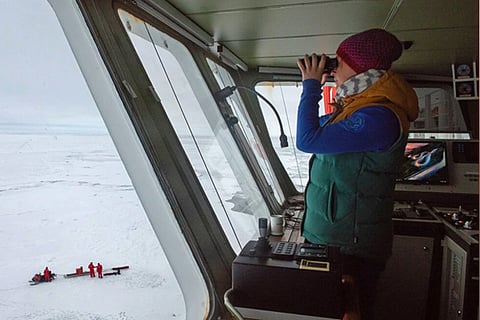

Chennai
The policy, set by leaders aboard the Akademik Fedorov, a Russian icebreaker and research vessel, prohibited passengers from wearing “thermal underwear” because it was a “safety issue,” said Chelsea Harvey, a journalist who was on the ship and whose story about the policy raised awareness of it last month.
The science institute leading the expedition, the Alfred Wegener Institute for Polar and Marine Research, denied in a statement that it had applied a dress code to a specific sex. It said that all of the participants on the trip were made aware of its policies at the beginning of the expedition, and that the dress code was raised again because of “repeated violations” of it and other rules.
“Sexual harassment, misconduct and discrimination, in any way, shape or form and regardless of when and where, are not tolerated by us or anyone acting on our behalf,” the statement said. The Fedorov was contracted by the institute to carry extra supplies and instruments for the Polarstern, the institute’s flagship vessel, which last year embarked on the largest and most ambitious climate-change research expedition ever in the Arctic. About two weeks into a six-week mission, leaders aboard the Fedorov brought up a strict dress-code policy to journalists, students and scientists on board, Harvey said. The next day, she said, in a smaller meeting with other journalists, it was explained that, as a “safety issue,” leggings, very tight-fitting clothing, short shorts and crop tops were not permitted.
The woman holding the meeting was “careful not to come right out and connect the dots,” Harvey said. “She did not say, ‘We are concerned that the men on board this ship will harass you if you dress a certain way,’ but she pointed out repeatedly there were a lot of men aboard this ship.” “The immediate reaction to our meeting was sort of shock and disbelief,” Harvey said, adding that there was widespread resentment and some alarm on the ship. After the meetings, women on the ship changed the way they dressed, she said, choosing to wear jeans and other loose-fitting clothing. “The implication that many people took from those meetings was that women should change the way they dress in order to manage the behaviour of men aboard the ship,” she said. She later discovered in her own reporting that there was an incident of sexual harassment on the ship, she said.
The institute said in its statement that some of its regulations prohibited wearing work or “sport clothing” in public areas. Such rules were intended to ensure people adhered to hygiene and safety standards in public areas like the mess halls and the ship’s bridge, it said. The dress code was discussed again in the context of other rules, the institute said, adding that there was no connection between harassment and “repeated admonitions to adhere to the dress code.”
A 2019 study on how gender bias affects women in science by the American Society for Microbiology found that, in 2015, women made up half of the college-educated U.S. work force in science but held 28 percent of jobs in those occupations.
A 2014 survey of academic field experiences by Plos One, a peer-reviewed open access journal, found that, of the more than 500 women who participated, 71 percent had been sexually harassed and 26 percent had been sexually assaulted. Female trainees were the primary targets, the survey said, and perpetrators were usually senior to them within a research team. Not many participants were aware of how to report such episodes, it said, and most who did report episodes were unsatisfied with the outcome.
Derrick Bryson Taylor is a reporter with NYT©2020
The New York Times
Visit news.dtnext.in to explore our interactive epaper!
Download the DT Next app for more exciting features!
Click here for iOS
Click here for Android